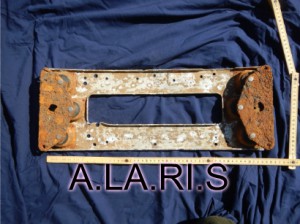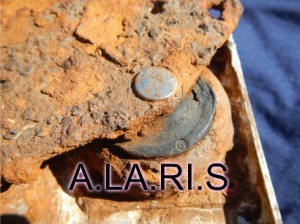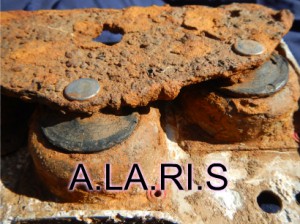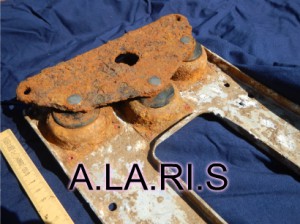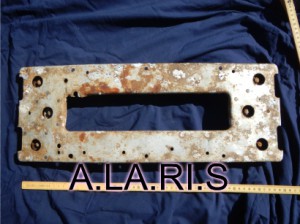Il ritrovamento è particolare sia per la tipologia del pezzo che per la località, alle spalle di Nettuno, dove è stato effettuato, visto che nella zona non sono noti campi di aviazione.
Il pezzo è sembrato subito interessante, sia perché è stato trovato insieme a bustine di razione di caffe US Army che per la presenza di sei smorzatori di vibrazione tipici di supporti per apparati radio, del tipo tuttora usati in applicazioni aeronautiche.
Le dimensioni sono 57x20x5 cm. circa.
Dopo la pulizia degli smorzatori è emerso su ciascun cuscinetto in gomma il nome della ditta costruttrice, LORD Co. ERIE PA. (www.lord.com), con sede appunto ad ERIE Pennsylvania USA, sulle sponde dell’omonimo lago Erie.
La LORD, che produce tuttora smorzatori per vibrazione anche per applicazioni aeronautiche, contattata, ci ha subito risposto e messo a disposizione due ingegneri del supporto tecnico, J. Markiewicz e G. Baker, per aiutarci ad identificare il ritrovamento attraverso i disegni di progetto (blue print) disponibili nel loro archivio.
Dopo un mese di ricerche di archivio i tecnici hanno confermato che il pezzo è un vassoio di supporto su cui veniva installata la radio, di impiego aeronautico e risalente al secondo conflitto mondiale.
Tuttavia i tecnici della LORD non sono riusciti ad identificare il tipo di aeromobile su cui era installato il pezzo per i due motivi che seguono: il primo è perché la LORD costruiva gli smorzatori che poi vendeva alla ditta costruttrice dell’apparato radio e non a quella costruttrice dell’aeromobile, il secondo perché il codice identificativo del modello degli smorzatori non è purtroppo leggibile sul pezzo, date le sue condizioni di preservazione.
A questo punto la ricerca si è spostata dagli archivi della LORD ad una ricerca sul campo presso il National Museum of the US Air Force (www.nationalmuseum.af.mil), per individuare un eventuale presenza del pezzo sugli aeromobili in esposizione presso il museo stesso. Il museo contattato direttamente dai tecnici della LORD purtroppo non ha rilevato la presenza del pezzo sugli aeromobili in esposizione.
In conclusione, l’analisi effettuata ha permesso di indentificare il pezzo come un vassoio di supporto per l’installazione di un’apparato radio di uso aeronautico, sicuramente risalente alla Seconda Guerra Mondiale, purtroppo però non è stato possibile risalire al modello aeromobile su cui veniva installato.
La ricerca estesa nei dintorni del ritrovamento non ha evidenziato altri oggetti utili alla identificazione del modello di aeromobile, per il momento…..
Si ringraziano i tecnici Mr. Markiewicz e Mr. Baker per la costante collaborazione nel mese che ha interessato la ricerca negli archivi LORD e presso il National Museum of US Air Force della Wright Patterson Air Force Base di Dayton OHIO.
Goffredo
———————————–
The finding is peculiar either for the piece itself and for the back area of Nettuno (ITALY) where it has been discovered, due to the fact that there are not airfields in the area.
The piece has immediately been filed as interesting, because it was located in the same hole with american K-ration coffee bags and due to the installation of six vibration dampers typical of radio equipment, still in use for aeronautical purposes.
Dimensions are: 60x20x5 cm.
After a good cleaning, dumpers were discovered to be engraved with “LORD Co.ERIE PA” (www.Lord.com) on each rubber bearing.
Lord is the name of the dampers manufacturer, having its headquarters in Erie, Pennsylvania USA, by the lake ERIE.
Lord, which still produces vibration dampers for aeronautical application, has been contacted and reported with the finding. They immediately put us in contact with 2 technical engineers, J.Markiewicz and G. Baker who were more than helpful to identify the finding through blue prints available in their files.
After a good month of research, the two technicians confirmed that the piece is a radio support tray for aeronautical installation and dated back to Second World War.
Nevertheless, the two technicians couldn’t identify the type of aircraft model the tray was installed on, for 2 main reasons: one is because LORD built dampers to be sold directly to the manufacturer of the radio equipment and not to the aircraft manufacturer. The second is because the identifying code (part number) of the dampers model is not visible due to the preservation conditions.
At this point, the research has moved from Lord archives to the National Museum of the US Airforce ( www.nationalmuseum.af.mil) to possibly identify a piece like ours, still built in one of the aircraft exposed in the museum itself. We are still waiting for final assessment by the museum personnel.
As a conclusion, the analysis conducted has allowed us to identify the piece as a tray support for the installation of radio equipment for aeronautical use dated back World War II, but to date it wasn’t possible to certify the model of aircraft the tray was installed on.
The research conducted in the neighborhood of the finding has not given any evidence of other aircraft pieces.
A warm thank you to LORD technicians, Mr Markiewicz and Mr Baker for the constant cooperation through LORD archives and through National Museum of US Airforce from Wright Patterson Airforce Base , Dayton OHIO, USA.
Goffredo

